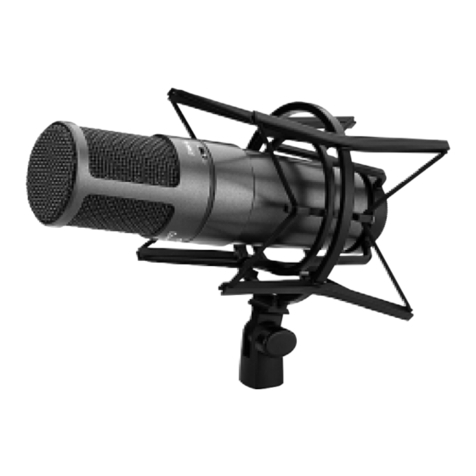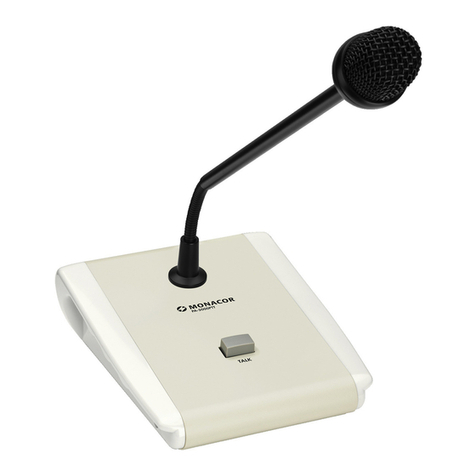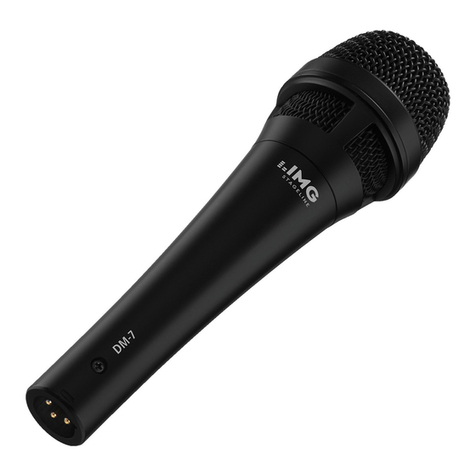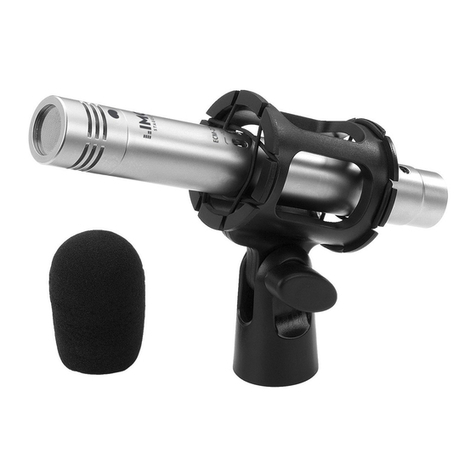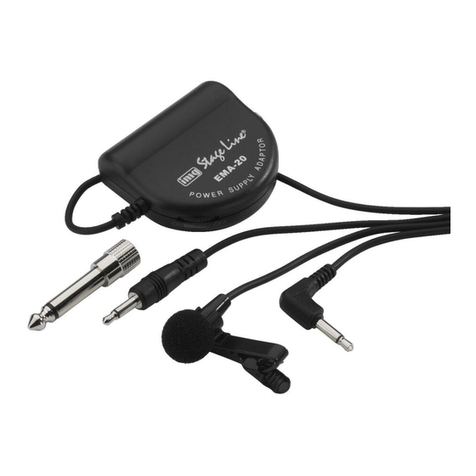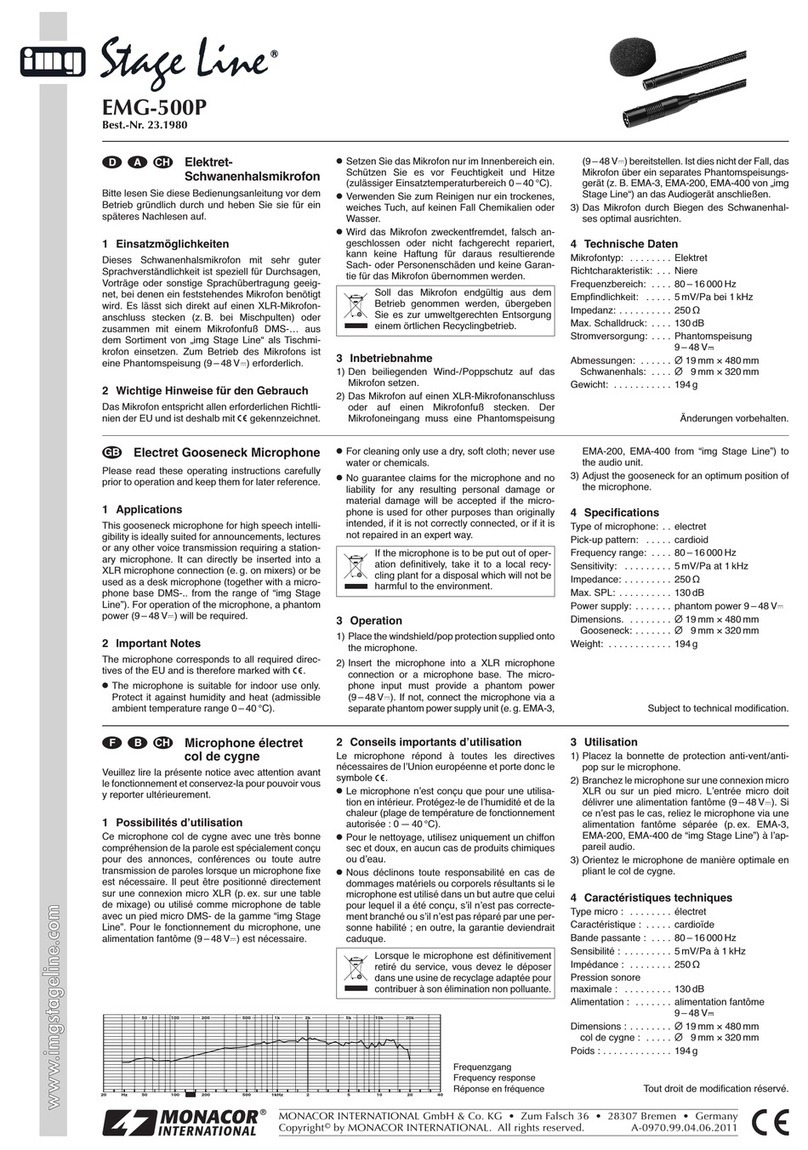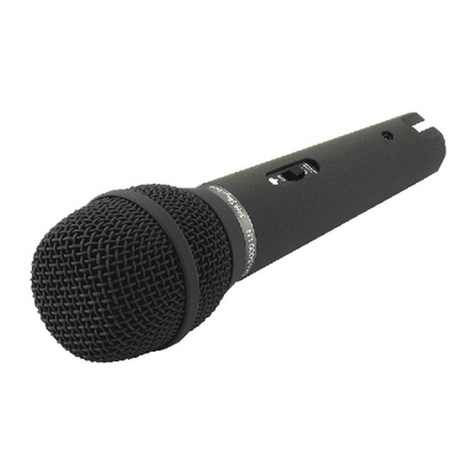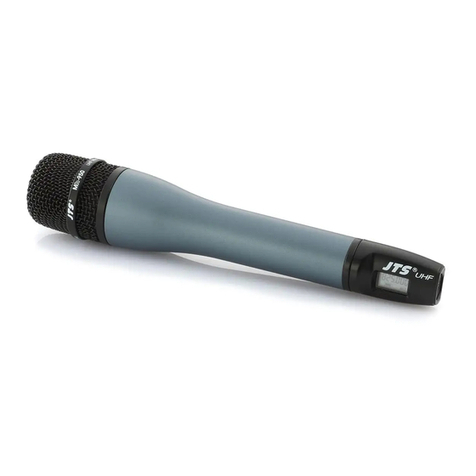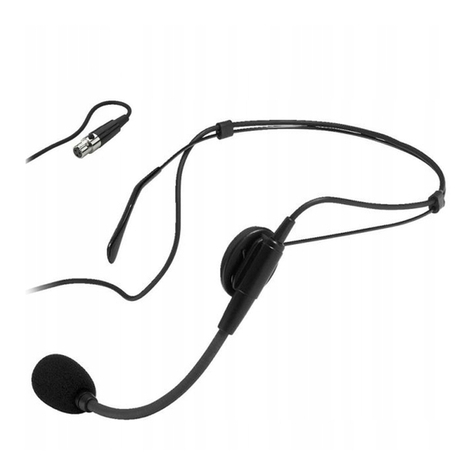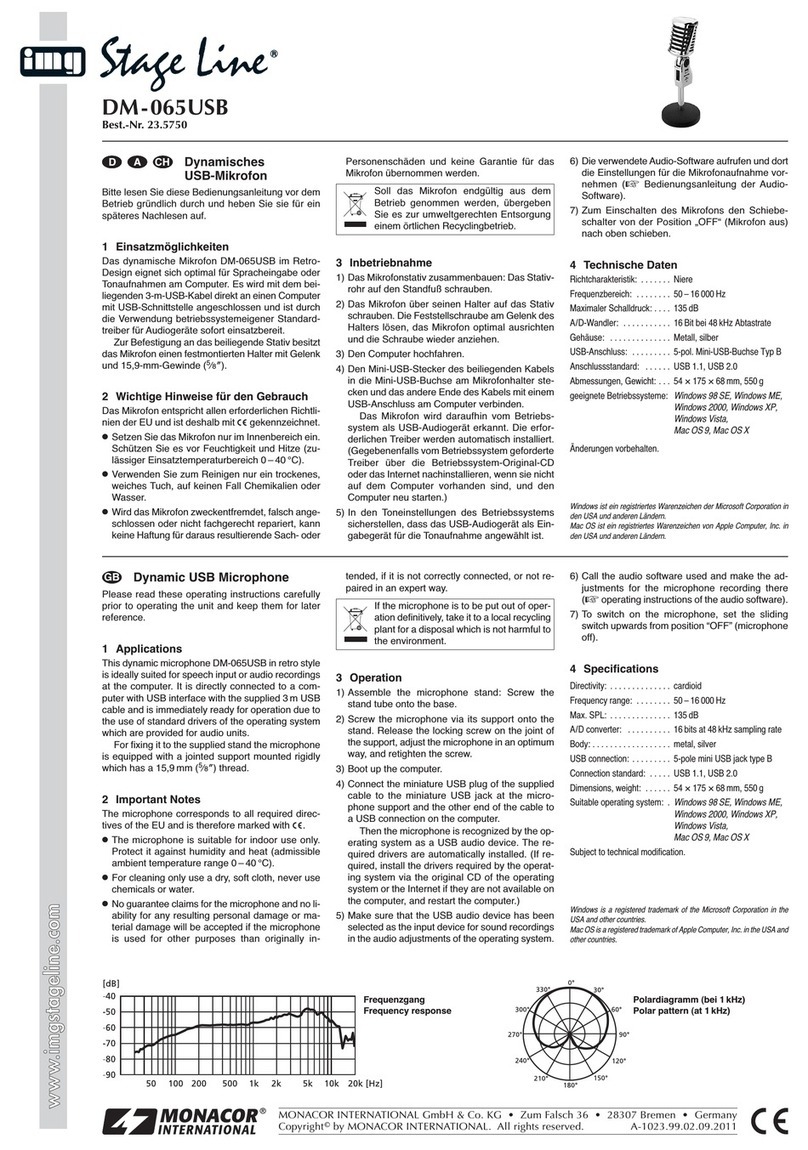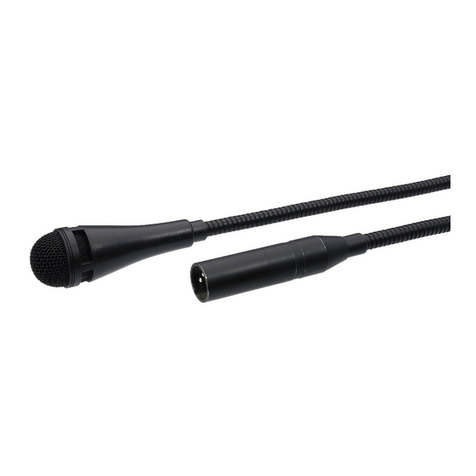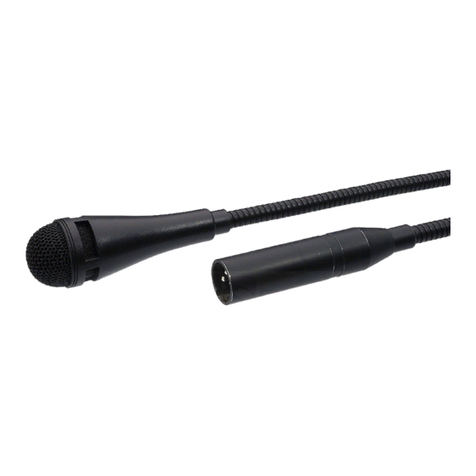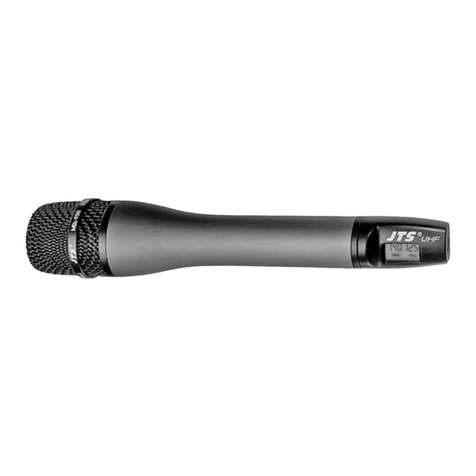Microphone électret
de studio
Possibilités d’utilisation
Le microphone back électret ECM-160 est conçu
pour une utilisation professionnelle en studio et sur
scène. Il est particulièrement recommandé pour la
prise de son d’instruments et les applications de
chant et de discours.
Le micro reçoit la tension d’alimentation néces-
saire pour le fonctionnement, via l’appareil audio
relié:l’entréemicrosurl’appareil audio doit disposer
d’une alimentation fantôme 48V. Un support atté-
nuateur de vibrations avec filetage 16mm (5/8") et
unebonnettedeprotectionsontlivrésaveclemicro.
Conseils de sécurité
Le microphone ECM-160 répond à la norme eu-
ropéenne 89/336/CEEE relative à la compatibilité
électromagnétique.
●Le microphone n’est conçu que pour une utilisa-
tion en intérieur; protégez-le de l’humidité et de
la chaleur (température d’utilisation admissible
0–40°C).
●Pour le nettoyer, utilisez un chiffon sec et doux,
en aucun cas de produits chimiques ou d’eau.
●Nous déclinons toute responsabilité si le micro-
phone est utilisé dans un but autre que celui pour
lequel il a été conçu, s’il n’est pas correctement
branché ou n’est pas réparé d’une manière ap-
propriée.
●Lorsque le microphone est définitivement retiré
du service, vous devez le déposer dans une
usine de recyclage adaptée.
Fonctionnement
1) Vissezle supportdumicrophone surunpiedpour
micro avec un filetage 16mm (5/8"), placez le
micro dans le support. Desserrez la vis sur le
support, orienter le microphone de manière opti-
male,puisrevissez.Sibesoin,placez la bonnette
de protection.
2) Reliez le microphone via un cordon de liaison
(p.ex. uncordondelasérie MEC-... de la gamme
“img Stage Line”) à une entrée micro XLR sur
l’appareil audio (p.ex. table de mixage, amplifi-
cateur). L’entrée micro doit être dotée d’une ali-
mentation fantôme 48V , dans le cas contraire,
le microphone ne peut pas fonctionner.
3) Le microphone dispose d’un filtre passe-haut
pour compenser l’effet de proximité dans les ap-
plications de chant et de discours. Pour activer la
diminution des graves, mettez l’interrupteur bas-
culant “LOW CUT” sur la position . S’il est
dans la position , le filtre est déconnecté.
Caractéristiques techniques
Type: . . . . . . . . . . . . . . . . back électret
Directivité: . . . . . . . . . . . . cardioïde
Bande passante: . . . . . . . 20–20000Hz
Sensibilité: . . . . . . . . . . . . 16,5mV/Pa à 1 kHz
Impédance: . . . . . . . . . . . 200Ω
Pression sonore max.: . . . 135dB
Rapport signal/bruit: . . . . 83dB
Fréquence de coupure
du filtre Low Cut: . . . . . . . 100 Hz
Alimentation: . . . . . . . . . . alimentation fantôme
48V
Température d’utilisation: . 0–40°C
Dimensions, poids: . . . . . Ø 52mm x 220mm
Poids: . . . . . . . . . . . . . . . . 470 g
Branchement: . . . . . . . . . XLR, symétrique
D’après les données du constructeur
Tout droit de modification réservé
Microfono professionale
all’elettrete
Possibilità d’impiego
Il microfono ECM-160 con la sua capsula di qualità
back-electret è previsto per l’impiego professionale
sul palcoscenico e nello studio di registrazione. È
indicato per la registrazione di strumenti musicali
nonché della lingua parlata e del canto.
La tensione di alimentazione viene dall’apparec-
chio audio collegato; ciò significa che l’ingresso
microfono dell’apparecchio audio dev’essere equi-
paggiato con alimentazione phantom 48V. In dota-
zione è un supporto per attenuare le vibrazioni, con
filettatura16mm (5/8")nonchéunaspugnaantivento.
Avvertenze di sicurezza
Il microfono corrisponde alla direttiva CE 89/336/
CEE sulla compatibilità elettromagnetica.
●Il microfono è previsto solo per l’uso all’interno di
locali. Proteggerlo dall’umidità e dal calore (tem-
peratura d’impiego ammessa fra 0°C e 40°C).
●Per la pulizia usare solo un panno morbido,
asciutto; non impiegare in nessun caso prodotti
chimici o acqua.
●Nel caso di uso improprio, di collegamento sba-
gliato o di riparazione non a regola d’arte non si
assume nessuna responsabilità per eventuali
danni.
●Se si desidera eliminare il microfono definitiva-
mente,consegnarloperlo smaltimento ad un’isti-
tuzione locale per il riciclaggio.
Messa in funzione
1) Avvitare il supporto del microfono su un treppie-
deper microfoni confilettatura16mm(5/8") edin-
serire il microfono nel supporto. Allentare la vite
di bloccaggio sul supporto ed orientare il micro-
fono secondo le necessità. Eventualmente met-
tere anche la spugna antivento, in dotazione.
2) Collegare il microfono con un ingresso microfono
XLR dell’apparecchio audio (p.es. mixer, amplifi-
catore) servendosi di un cavo di collegamento
(p.es.uncavo della serieMEC-…del programma
“img Stage Line”). L’ingresso microfono deve es-
sere equipaggiato con un’alimentazione phantom
48V ,altrimentiil microfonononpuò funzionare.
3) Il microfono è equipaggiato con un filtro passa
alto per compensare l’effetto dovuto alla vicinan-
za della bocca nel canto e nel parlare. Per atti-
vare l’abbassamento dei bassi portare l’interrut-
tore a bascula “LOW CUT” in posizione . Se
l’interruttore si trova in posizione , il filtro è
disattivato.
Dati tecnici
Tipo: . . . . . . . . . . . . . . . . . back-electret
Caratteristica: . . . . . . . . . . a cardioide
Banda passante: . . . . . . . 20–20000Hz
Sensibilità: . . . . . . . . . . . . 16,5mV/Pa a 1kHz
Impedenza. . . . . . . . . . . . 200Ω
Pressione sonora max.: . . 135dB
Rapporto S/R: . . . . . . . . . 83dB
Frequenza di taglio
del filtro low-cut: . . . . . . . . 100Hz
Alimentazione: . . . . . . . . . alimentazione phantom
48V
Temperatura d’impiego. . . 0–40°C
Dimensioni. . . . . . . . . . . . Ø 52mm x 220mm
peso: . . . . . . . . . . . . . . . . 470g
Collegamento . . . . . . . . . . XLR, simmetrico
Dati forniti dal produttore.
Con riserva di modifiche tecniche.
I
Copyright©by MONACOR®International GmbH & Co. KG, Bremen, Germany. All rights reserved. 12.00.01
®
ECM-160
Best.-Nr. 23.2740
wwwwww..iimmggssttaaggeelliinnee..ccoomm
